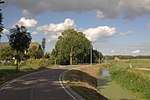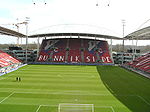Fectio
0s establishments in the Roman Empire1st-century establishmentsAncient Roman military stubsBuildings and structures in Utrecht (province)Bunnik ... and 3 more
Dutch history stubsRoman fortifications in Germania InferiorRoman legionary fortresses in Netherlands

Fectio, known as Vechten in Old Dutch, was a Roman castellum in the province Germania Inferior established in the year 4 or 5 AD. It was located at the place where the river Vecht (Fectio) branched off from the Rhine, leading to Lake Flevo, which was later to become the Zuiderzee. This was near the modern hamlet of Vechten in the municipality Bunnik, Utrecht, Netherlands.
Excerpt from the Wikipedia article Fectio (License: CC BY-SA 3.0, Authors, Images).Fectio
Rijksweg A12, Bunnik
Geographical coordinates (GPS) Address Website Nearby Places Show on map
Geographical coordinates (GPS)
| Latitude | Longitude |
|---|---|
| N 52.056388888889 ° | E 5.165 ° |
Address
Fort Vechten (Fort bij Vechten)
Rijksweg A12
3981 HE Bunnik
Utrecht, Netherlands
Open on Google Maps





